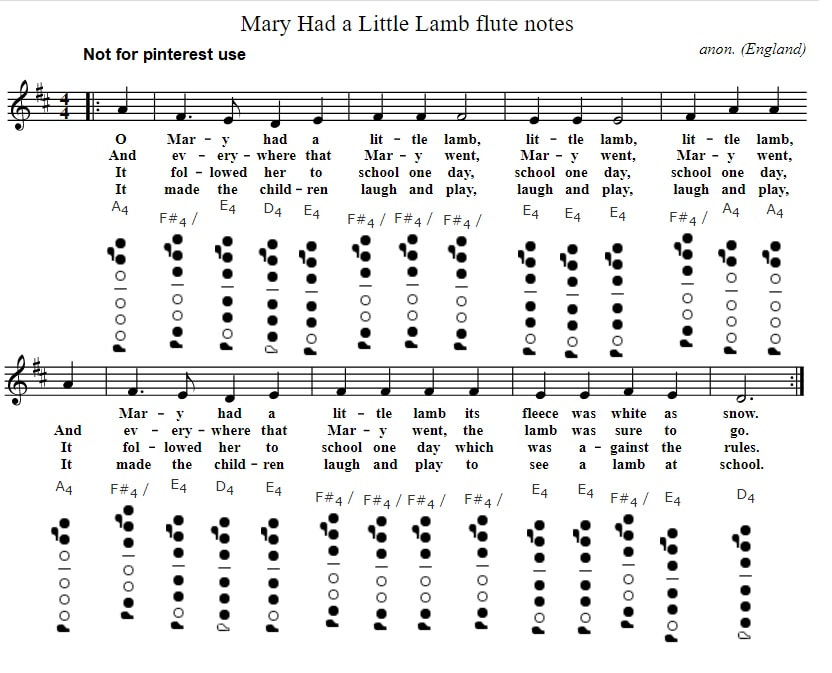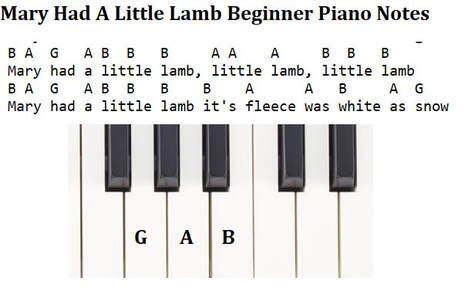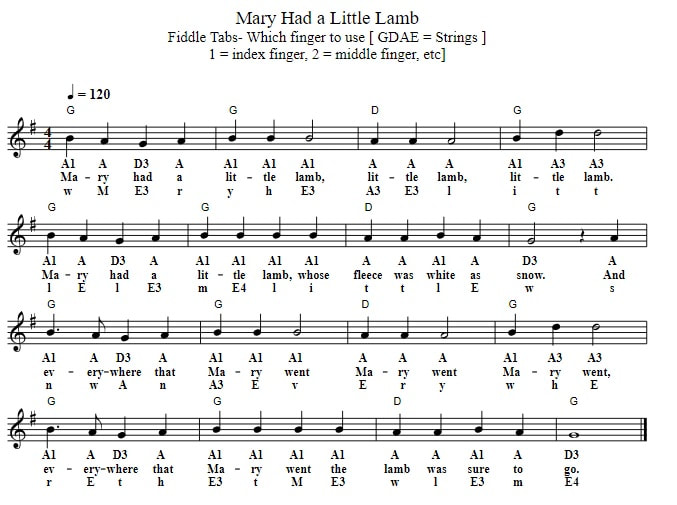Mary Had A Little Lamb Tin Whistle Sheet Music
Mary had a little lamb easy beginner piano letter notes now added plus the flute notes showing the finger position. First published in America but it's origins are British and it's based on a true story. It's a popular nursery rhyme / poem.Mary had a little lamb solfege sheet music notes are also included. Also included is the tin whistle sheet music for Three Blind Mice which is another children's song from England. Return to my selection of Children's Songs On Tin Whistle .Mary had a little Lamb beginner violin sheet music in this keys of D and G Major added for beginners. These tabs show which fingers to use while playing the strings. The piano chords are in 3 of the versions. The fingerstyle guitar tab plus the mandolin / tenor banjo tabs included.
Mary Had a Little Lamb: The Enduring Legacy of a Classic Children’s Nursery Rhyme
The nursery rhyme “Mary Had a Little Lamb” is one of the most recognizable and beloved pieces of children’s literature. Composed by Sarah Josepha Hale in 1830, it tells the simple story of a young girl named Mary and her devoted lamb. Though it may seem like a simple and innocent tale, the enduring popularity and cultural impact of “Mary Had a Little Lamb” reveal a deeper significance and complexity. This thesis will explore the origins, evolution, and enduring legacy of this classic nursery rhyme, examining its cultural significance and impact on literature, music, and popular culture.
To understand the origins of “Mary Had a Little Lamb,” it is important to first examine the life of its author, Sarah Josepha Hale. Born in 1788, Hale was a prolific writer, editor, and advocate for women’s education. She is best known for her role in establishing Thanksgiving as a national holiday, but her contributions to children’s literature are equally significant. In addition to “Mary Had a Little Lamb,” Hale wrote numerous other nursery rhymes and children’s stories, including “Twinkle, Twinkle, Little Star” and “Old Mother Hubbard.”
“Mary Had a Little Lamb” first appeared in Hale’s book, “Poems for Our Children,” published in 1830. It gained widespread popularity through its inclusion in the “Mother Goose’s Melody” collection of nursery rhymes in 1833. The simple yet catchy melody and easy-to-remember lyrics made it a favorite among children and parents alike. The rhyme’s popularity only continued to grow, and it has been translated into multiple languages and adapted into various forms, including picture books, cartoons, and songs.
One of the most significant adaptations of “Mary Had a Little Lamb” is the musical version composed by Lowell Mason in 1834. Mason’s adaptation gave the nursery rhyme a new life, as it became a popular song in classrooms and homes across the country. The song’s simple melody and repetition made it a perfect teaching tool for young children learning to read and write. It also helped to solidify the rhyme’s place in American popular culture.
As “Mary Had a Little Lamb” continued to gain popularity, it also began to take on new meanings and interpretations. Some saw the rhyme as a simple tale of a child and her pet, while others saw it as a commentary on societal norms and expectations. The lamb, seen as a symbol of innocence and purity, could be seen as a representation of Mary herself, a young girl navigating a world dominated by adults. In many ways, “Mary Had a Little Lamb” can be seen as a subversive piece of literature, subtly challenging societal norms and expectations through its innocent facade.
The rhyme’s impact on literature extends far beyond its original publication. It has been referenced and alluded to in numerous works of literature, from Mark Twain’s “The Adventures of Tom Sawyer” to Robert Frost’s poem “Mary and Her Little Lamb.” Its enduring popularity and widespread recognition make it a powerful cultural symbol, evoking nostalgia and childhood memories for many.
Aside from literature, “Mary Had a Little Lamb” has also had a significant impact on music and popular culture. The song has been recorded by countless artists, ranging from country singer Dolly Parton to rock band Steppenwolf. Its catchy melody and simple lyrics have made it a staple in children’s music, and its variations have been used in everything from commercials to movie soundtracks.
In conclusion, “Mary Had a Little Lamb” is much more than just a simple nursery rhyme. Its origins, evolution, and enduring popularity have made it a cultural phenomenon, with a legacy that extends far beyond its original publication. From its humble beginnings in the 19th century to its continued presence in literature, music, and popular culture, “Mary Had a Little Lamb” has cemented its place as a beloved and enduring piece of children’s literature. Its timeless message of innocence, childhood, and the enduring bond between a child and their pet continues to resonate with audiences of all ages, making it a true classic that will continue to be cherished for generations to come.
The nursery rhyme “Mary Had a Little Lamb” is one of the most recognizable and beloved pieces of children’s literature. Composed by Sarah Josepha Hale in 1830, it tells the simple story of a young girl named Mary and her devoted lamb. Though it may seem like a simple and innocent tale, the enduring popularity and cultural impact of “Mary Had a Little Lamb” reveal a deeper significance and complexity. This thesis will explore the origins, evolution, and enduring legacy of this classic nursery rhyme, examining its cultural significance and impact on literature, music, and popular culture.
To understand the origins of “Mary Had a Little Lamb,” it is important to first examine the life of its author, Sarah Josepha Hale. Born in 1788, Hale was a prolific writer, editor, and advocate for women’s education. She is best known for her role in establishing Thanksgiving as a national holiday, but her contributions to children’s literature are equally significant. In addition to “Mary Had a Little Lamb,” Hale wrote numerous other nursery rhymes and children’s stories, including “Twinkle, Twinkle, Little Star” and “Old Mother Hubbard.”
“Mary Had a Little Lamb” first appeared in Hale’s book, “Poems for Our Children,” published in 1830. It gained widespread popularity through its inclusion in the “Mother Goose’s Melody” collection of nursery rhymes in 1833. The simple yet catchy melody and easy-to-remember lyrics made it a favorite among children and parents alike. The rhyme’s popularity only continued to grow, and it has been translated into multiple languages and adapted into various forms, including picture books, cartoons, and songs.
One of the most significant adaptations of “Mary Had a Little Lamb” is the musical version composed by Lowell Mason in 1834. Mason’s adaptation gave the nursery rhyme a new life, as it became a popular song in classrooms and homes across the country. The song’s simple melody and repetition made it a perfect teaching tool for young children learning to read and write. It also helped to solidify the rhyme’s place in American popular culture.
As “Mary Had a Little Lamb” continued to gain popularity, it also began to take on new meanings and interpretations. Some saw the rhyme as a simple tale of a child and her pet, while others saw it as a commentary on societal norms and expectations. The lamb, seen as a symbol of innocence and purity, could be seen as a representation of Mary herself, a young girl navigating a world dominated by adults. In many ways, “Mary Had a Little Lamb” can be seen as a subversive piece of literature, subtly challenging societal norms and expectations through its innocent facade.
The rhyme’s impact on literature extends far beyond its original publication. It has been referenced and alluded to in numerous works of literature, from Mark Twain’s “The Adventures of Tom Sawyer” to Robert Frost’s poem “Mary and Her Little Lamb.” Its enduring popularity and widespread recognition make it a powerful cultural symbol, evoking nostalgia and childhood memories for many.
Aside from literature, “Mary Had a Little Lamb” has also had a significant impact on music and popular culture. The song has been recorded by countless artists, ranging from country singer Dolly Parton to rock band Steppenwolf. Its catchy melody and simple lyrics have made it a staple in children’s music, and its variations have been used in everything from commercials to movie soundtracks.
In conclusion, “Mary Had a Little Lamb” is much more than just a simple nursery rhyme. Its origins, evolution, and enduring popularity have made it a cultural phenomenon, with a legacy that extends far beyond its original publication. From its humble beginnings in the 19th century to its continued presence in literature, music, and popular culture, “Mary Had a Little Lamb” has cemented its place as a beloved and enduring piece of children’s literature. Its timeless message of innocence, childhood, and the enduring bond between a child and their pet continues to resonate with audiences of all ages, making it a true classic that will continue to be cherished for generations to come.
Mary had a little lamb beginner piano notes
Mary had a little lamb solfege sheet music notes
The youtube version of the tab has a different version.
Mary had a little Lamb beginner violin sheet music in D Major showing which strings to play.
Mary had a little lamb mandolin tab
Included below is the fingerstyle guitar tab
The youtube video has the letter notes for recorder.
Below is the list of sheet music and tin whistle songs that are in my ebooks. This is the largest collection of tin whistle songs ever put together.[over 800 songs ] Including folk, pop and trad tunes plus German And French songs along with Christmas Carols.
All of the sheet music tabs have been made as easy to play as was possible.
The price of the ebooks is €7.50
All of the sheet music tabs have been made as easy to play as was possible.
The price of the ebooks is €7.50












